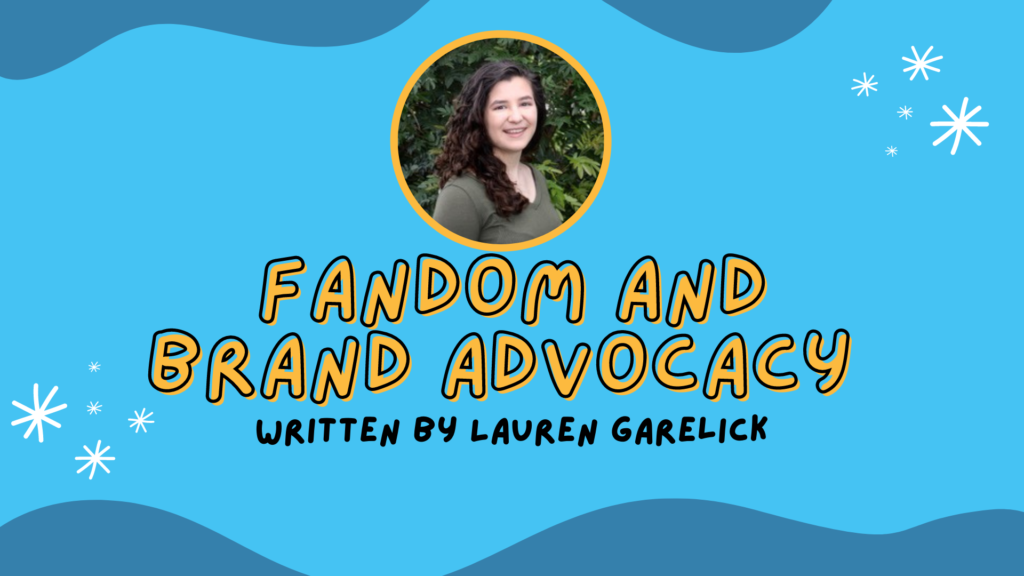Fandom and Brand Advocacy

What do you think of when you hear the word “fandom”? How about the word “stan”? Your first thought might be a crowd of screaming girls at a Harry Styles concert. Or maybe you think of a bunch of crazed teenagers fighting for the attention of celebrities online. When I think of fandoms and stans, I think of organized advocacy groups that are experts in social media communications.
Officially, the term “fandom” is defined as “the fans of a particular person, team, TV show, etc. considered together as a community.” A “stan” is a member of one or more fandoms, defined as “an overzealous or obsessive fan, especially of a particular celebrity.”
There are abundant examples of the power of fandoms. When the hit sitcom Brooklyn 99 was cancelled after its fifth season in 2018, sitcom stans got it renewed with the help of influencers like Seth Meyers and Lin-Manuel Miranda. When K-pop group BTS donated one million dollars to Black Lives Matter last year, their stans — known widely as the BTS Army — matched that donation in 24 hours. And over the last year, stans of Lil Nas X have made him the most-streamed male rapper on Spotify. Fandoms are a crucial part of today’s social media landscape, and there’s a lot we can learn from them.
Create online spaces that foster community.
Every brand wants a group of loyal advocates, but how many brands are creating spaces for them to come together? Making space for advocates to meet and bond sets the framework for an online community that is strong and centralized. Those who are loyal to your brand will know where they can go to ask questions, give opinions or meet people with similar interests.
Right now, most of these spaces are fan made and online. They include Facebook groups, Reddit discussion threads, live tweet sessions, discord servers, listening parties, Instagram and TikTok lives, and most recently, Twitter Spaces. Across these platforms, the main idea is the same: people are looking for places to discuss their interests with others like them. So why not put your brand at the center of that conversation?
This doesn’t mean all brands should start posting on Reddit or going live on TikTok. It’s important for organizations to meet their communities where they already are, and that will take intensive social listening. However, once brands understand how, when and where their brand advocates come together, they can begin to create similar spaces of their own to foster those communities.
Make influencer marketing authentic.
Another lesson we can learn from fandoms is how to master influencer marketing. Most fandoms are centered around influencers, most commonly actors or musicians. In fandom communities, they are often known as favorites, or “favs.” Stans are incredibly loyal to their favs, and they will dedicate time, effort and money to see them succeed.
One of the secrets to creating this level of loyalty is authenticity. When stans feel like they have meaningful relationships with their favs, they are motivated to support them. The same principle applies to brands: stakeholders will have stronger connections with influencers when they feel like they share an authentic relationship. To foster authentic relationships, make sure influencers are truly dedicated to your organization and eager to interact with its community. Through these interactions, stakeholders will become loyal to your influencers and to your organization by extension.
Recognize and reward brand advocates.
Stans love being recognized, and the same is true for brand advocates. They spend a significant amount of time talking about how much they love your brand, so it’s only fair that they receive the same amount of love in return. Community management and customer service teams can help with this by liking, sharing, and replying to brand love. This will result in even more goodwill and encourage brand advocates to keep supporting your organization.
Even with these efforts, organizations can go farther to appreciate brand advocates. For advocates who are especially loyal or have large audiences of their own, there is potential for brand partnerships. Organizations can send these advocates merchandise, include them in campaigns or cement them as influencers if efforts are successful.
Key Takeaways.
Overall, fandoms and stans are widely underestimated, and it’s time the public relations industry puts their practices into action. Fostering online communities, creating authentic influencer partnerships, and rewarding brand advocates can help organizations take advantage of the loyal and powerful community groups we know the internet creates. These groups are more than a crazy phenomenon on social media — they’re the future of brand advocacy.

Lauren Garelick is a junior at the University of Florida studying public relations with a minor in Spanish. She is the director of fundraising and special events for UF PRSSA, and she is an account supervisor at the University of Florida’s Student-run Firm Alpha PRoductions. Connect with her on Twitter and LinkedIn.
